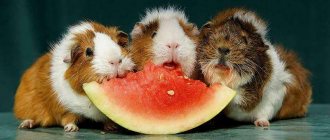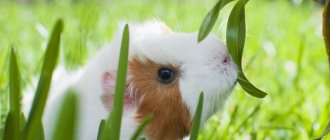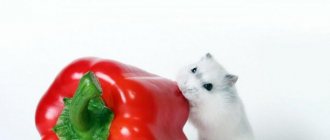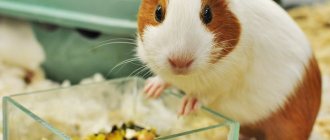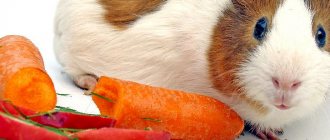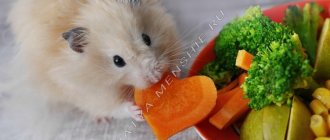The guinea pig is a very interesting pet that needs good care and company. The diet should include food that they consume in the wild. This is the only way to maintain strong immunity and normal functioning. You need to know what guinea pigs eat before purchasing one. Proper nutrition is extremely important and the health and life of the animal will depend on it. For starvation, 1–2 days without food is enough.
Feeding rules
Proper nutrition is about caring for your pet’s health, as well as the condition of its hair and teeth. A guinea pig's daily diet should consist of:
- dry food – 20%;
- succulent feed – 20%;
- green fodder – 10%;
- hay – 50%.
By following a few simple feeding rules, you can keep your guinea pig healthy:
- Rodents are fed 3 times a day.
- The feeder is not removed from the cage; the pig must always have food.
- The presence of hay in the cage is mandatory; the supply of hay must be established immediately.
- If dry food is not included in the pet’s menu, then the portion of fresh vegetables and herbs is increased to 150 grams. in a day.
- It is better to diversify your diet by offering different foods every day.
- Ideally, a daily portion of food contains at least 3 types of vegetables and herbs.
- Collecting herbs near roads and factories is prohibited.
- It is recommended to give fruits in the first half of the day, and dry food in the second half of the day.
Guinea pig diet
Cereals and pelleted feeds
This type of diet is based on grain crops and ready-made food, containing all the necessary vitamins and mineral supplements for the healthy growth and development of a domestic rodent.
Nutrition Features:
- You need to buy only high-quality food from trusted manufacturers for your guinea pig. Cheap food contains many harmful and unnatural ingredients that can cause serious health problems.
- Dry food must be supplemented with moist, juicy food.
- Clean drinking water should always be freely available to your pet.
- It is not advisable to feed high-calorie foods to inactive rodents.
Advantages of nutrition: ready-made food has a solid structure, which helps the animal grind its teeth, convenient use of food, no need to prepare special food for the rodent.
Disadvantages: you need to constantly purchase food for your pet and always have a certain supply of it in the house.
On our store’s website you can select and buy high-quality industrial food for domestic guinea pigs from reliable global manufacturers. The range includes cozy cages for rodents, comfortable drinking bowls, special toilets with nozzles, various accessories for games and much more.
Dry food
Dry food is sold in pet stores and can frighten a novice pig breeder with its variety. To select a product, you can use the recommendations of experienced breeders and rely on the information indicated on the package:
- The high content of fatty components (seeds, nuts), sugar, cellulose and animal proteins indicates that the mixture is not suitable for daily use.
- The presence of dyes does not justify itself; the pet does not care what color the granules are.
- The composition should be balanced with a predominance of cereals;
- The content of coarse fibers and vegetable proteins is at least 20%.
- Vitamin C is a must.
Preparing such a mixture yourself will not be difficult. The feed usually includes:
- cereals;
- seeds;
- corn;
- legumes;
- dried fruits;
- dried vegetables;
- herbal component.
Green food
The benefits of green food are obvious:
- natural food of guinea pigs;
- have a good effect on digestion;
- provide the body with necessary vitamins and other beneficial substances.
Among the plants there are poisonous ones that can harm the health of rodents. When collecting grass, it is recommended to focus on the list of permitted feed:
- alfalfa;
- dandelion;
- tops (carrots and beets);
- clover;
- plantain;
- chamomile;
- tansy;
- whine;
- young sedge;
- yarrow;
- dill;
- parsley;
- spinach;
- salad;
- sprouted grains;
- celery;
- leaves of garden berries;
- mint.
Juicy food
Juicy food is also beneficial for the pig's digestion and teeth. Vegetables and fruits are healthy treats for guinea pigs. To a greater extent it should be vegetables:
- carrot;
- pumpkin;
- beet;
- cauliflower and white cabbage;
- cucumbers;
- zucchini;
- bell pepper;
- rutabaga and turnip.
Sometimes animals are offered fruits and berries as treats:
- apples;
- pears;
- cherries;
- plums;
- peaches;
- apricots;
- citrus fruits (very rarely).
Fruits and berries
Bananas
Can guinea pigs have bananas? A banana rich in potassium will benefit your guinea pig, but you should not give more than 1 piece per day.
The peel of the vegetable must be removed, as it is treated with substances hazardous to health (wax, chemicals, ethylene and pesticides). For safety, it is better to remove soft fibers from the fruit.
I'm eating a banana! Om-Nom-nom. I won't give it to you!
Can guinea pigs eat a pear?
Pears can be given with the peel, but without the seeds. The fruit is washed well and cut into pieces; the pig should be offered water along with it. Excessive consumption of pears due to their high sugar content can cause diarrhea.
Can guinea pigs eat kiwi?
Kiwi is a very healthy fruit for animals. It contains a large amount of ascorbic and folic acids. It is also rich in vitamins E, iron, calcium, magnesium and phosphorus.
Kiwi is given without skin in the form of small pieces. For your pet, you need to choose harder fruits. It is better to control the amount you eat. An increase in the dose of kiwi is permissible in autumn and winter, as well as when feeding females during pregnancy and lactation.
Can guinea pigs have oranges and other citrus fruits?
Can be used occasionally. But it is better for guinea pigs to get vitamin C from other foods, avoiding citrus fruits. Possible complications:
- oversaturation with vitamins;
- skin irritation;
- oxidation of urine.
Can guinea pigs eat apples?
Apples can be raw or dried. They have a balanced ratio of sugar and fructose (18:80%). It allows the pig to be active.
The fruit must be peeled and cut into slices. It is better not to give more than 3 pieces at a time.
Can guinea pigs eat strawberries, grapes and other berries?
Strawberries contain a sufficient amount of vitamin C to pay attention to the berry when choosing a treat for a rodent. You can also give strawberry leaves to animals.
- The pig might like grapes. You can offer the animal seedless grapes.
- Eating currants once a week will also not harm your pet.
- If you do not abuse it, you can offer the pig berries and raspberry leaves, berries, leaves and branches of blueberries, blackberries and sea buckthorn, and rose hips without seeds.
- Cranberries are given for medicinal purposes. It has an anti-inflammatory effect on the mucous membranes of the mouth, stomach, and bladder.
Seeds, nuts and other foods
Active pigs need high-calorie foods. In this case, sunflower seeds, flax and sesame seeds, as well as nuts, are indispensable. If the animal gains weight too quickly, these foods are excluded from the diet.
- You can give rodents wheat bran, green peas, and sometimes cereals.
- It is very useful to give your pet branches of fruit trees to wear down teeth and replenish mineral reserves.
- Dried fruits are suitable as a “holiday” treat. In large quantities they are dangerous for the animal.
Vitamins and minerals
Here we should dwell separately on vitamin C. The body of guinea pigs is designed in such a way that vitamin C is not produced in it at all. To compensate for its deficiency, the animal needs to eat foods rich in this vitamin. Additionally, ascorbic acid is added to the rodents' drink.
Other important components for maintaining the life of guinea pigs are salt and calcium. The animal can obtain them in the form of mineral stones.
Vitamins K and B are absorbed in the body of animals only during secondary processing, so pigs often eat their litter. You should not stop your pet if he does this.
You can also add meat and bone meal and fish oil to your guinea pigs' diet as food additives.
Hay
Due to the special structure of the gastrointestinal tract, the nutrition of guinea pigs must be organized so that they can eat hay every day. This is their favorite food, which stimulates the digestive system and prevents the occurrence of intestinal diseases. You can purchase it at a pet store or prepare it yourself.
When choosing purchased hay, it is important to pay attention to its aroma. It should smell like grass, not damp.
You need to carefully ensure that the hay that guinea pigs eat does not contain large, coarse twigs, dust or other contaminants.
If you wish, you can feed the animals with your own prepared hay. It is recommended to collect raw materials for it away from swamps, highways and industrial enterprises. You need to dry the grass for the winter for at least 1.5-2 months, and it should not turn black or turn black.
On a note. It is especially useful to feed the rodent legume-cereal and bean hay. It contains all the vitamins a guinea pig needs.
Water
Having a fresh portion of drink in your pet's cage is a must. 250 ml is enough for one animal. Pregnant females require more fluid.
It is wrong to use boiled water. Filtered or bottled water will do. The cleanliness of the drink must be carefully monitored, since an infection can enter the animal’s body along with garbage.
It is recommended to use an automatic waterer, which will be a constant source of water for the pigs. With such a drinker, the water will be protected from contamination and spillage.
What are the consequences of violating the nutritional rules?
According to statistics, pigs most often die due to intestinal disorders. With improper feeding, the microbial balance in the digestive tube is disrupted, the breakdown of cellulose is difficult, food is not properly digested, and death occurs from intoxication with metabolic products. This is why it is so important to monitor your diet and feeding regimen.
Feed must be of good quality and fresh, it must smell good, and have no signs of spoilage or mold damage. It is important that products are stored in places inaccessible to insects and wild rodents - carriers of dangerous diseases.
Prohibited Products
It has already been said above that some foods are harmful to guinea pigs. In order not to harm his pet, the owner needs to know the list of foods that piglets should not eat:
- chocolate, candies and other sweets;
- baked goods and pasta;
- rice;
- potato;
- saltiness, smokedness;
- products of animal origin;
- burdock;
- sorrel;
- green onions;
- salad mustard;
- mushrooms;
- chestnuts;
- garlic;
- horseradish;
- radish;
- salt, spices, sugar.
Which tree branches are prohibited from giving:
- oak;
- rowan;
- buckthorn;
- willow;
- hornbeam;
- elm;
- all coniferous branches.
What not to feed a guinea pig
There is a list of harmful foods that you should absolutely not feed to your pet guinea pig. They are absolutely useless for their body, and some of them can cause serious health problems.
What not to give to rodents:
- Prohibited vegetables: radish, radish, onion, potato, eggplant, garlic, horseradish.
- Harmful fruits: dates, persimmons, lemon, lime, pomegranates and grapefruits.
- Do not feed your pet sorrel, rhubarb greens, green onions, garlic, as well as lavender, motherwort, celandine, belladonna, serpentine, valerian, wild rosemary, fern, sow thistle and hemp seeds.
- Branches of fir, quince, oak, pine and spruce are prohibited for rodent food.
- Beans and boiled peas should not be given as legume products.
- Meat and dairy products, eggs, sweets and baked goods are prohibited in any form.
It is also unacceptable to give guinea pigs food from your table, low-quality food, spoiled and stale food, indoor greens, canned food, spices, mushrooms and fruit seeds.
Pregnant pig and newborn piglets: feeding and care
A pregnant guinea pig and small piglets require special care. The expectant mother needs to eat regularly. Her menu should be enriched with vitamins and protein. It is better if during this period the animal eats sprouted wheat grains, beets, carrots and alfalfa.
Part of the pet's cage is shaded and a drinking bowl is installed there. Milk is added to the female's drink. It is also recommended to drink rosehip infusion or tomato juice.
If the new mother does not have milk, the owner will have to take care of it and feed the newborn pigs themselves from a syringe. Caring for offspring is a responsible and enjoyable activity. Cream (10%) is used as food for piglets. You will also need to give your kids the drug Linex.
Feed for small pigs is given 1 ml every hour. The required amount of cream is drawn into the insulin syringe (without a needle). 1/10 of the Linex capsule is added to the mixture. This mash is very nutritious and healthy. The food, warmed to room temperature, is squeezed out drop by drop. From the second week, the offspring can be fed with baby milk-free porridge. Gradually, the kids are transferred to “adult” food.
